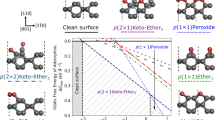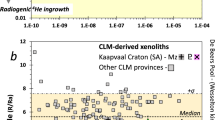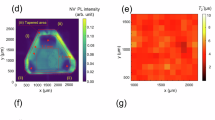Abstract
LET us grant, in accordance with Galimov's proposals1, that cavitation can occur when flowing magma in a pipe encounters a constriction, and that in the ensuing collapse of a bubble very substantial transient dynamic pressures, of magnitude sufficient to be of thermodynamic importance for diamond synthesis, can be produced. In granting this, we overlook some quantitative details in his calculation, such as the apparent implication that the bubbles would contain gas at 10 or 20 kbar, and yet that their compression (by a factor of 64,000 in volume) can be calculated by ideal gas theory. He ignores the fundamental difference in rate control between martensitic conversion of crystals from one modification to another, which makes a product of the same chemical composition as the starting material, and other processes of crystal growth requiring a composition change. In the former class, to which production of diamond by the action of shock waves on graphite belongs, the limit on growth velocity is essentially the shock wave velocity. Thus, so far as that is concerned, quite a large diamond might be made within a few microseconds. Further characteristics of martensitic processes are, however, that the product takes the form of thin lenses, whereby the constraint by the matrix on shape change in the converting region is minimised and, second, that as a rule there is a multiplicity of orientations of the martensitic product in the parent crystal, so that a microcrystalline product results.
This is a preview of subscription content, access via your institution
Access options
Subscribe to this journal
Receive 51 print issues and online access
$199.00 per year
only $3.90 per issue
Buy this article
- Purchase on SpringerLink
- Instant access to full article PDF
Prices may be subject to local taxes which are calculated during checkout
Similar content being viewed by others
References
Galimov, E. M., Nature, 243, 389 (1973).
Takagi, M., and Lang, A. R., Proc. R. Soc., A 281, 310 (1964).
Lang, A. R., Nature, 213, 248 (1967).
Frank, F. C., Proc. int. Industrial Diamond Conf., Oxford, 119 (Industrial Diamond Information Bureau, London, 1967).
Moore, M., and Lang, A. R., Phil. Mag., 25, 219 (1972).
Moore, M., and Lang, A. R., Phil. Mag., 26, 1313 (1972).
Author information
Authors and Affiliations
Rights and permissions
About this article
Cite this article
FRANK, F., LANG, A. & MOORE, M. Cavitation as a Mechanism for the Synthesis of Natural Diamonds. Nature 246, 143–144 (1973). https://doi.org/10.1038/246143a0
Received:
Issue date:
DOI: https://doi.org/10.1038/246143a0



